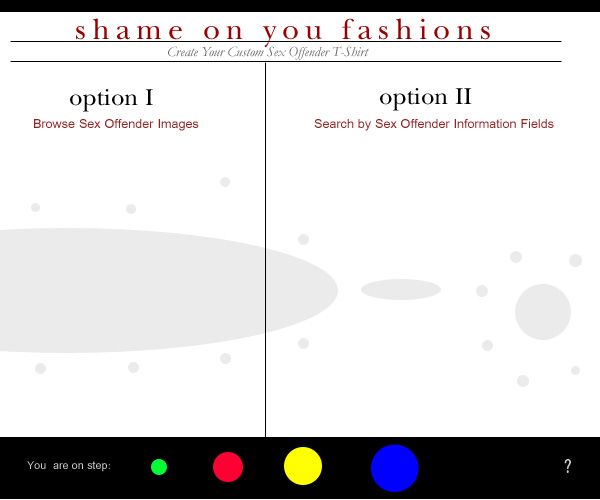

Shame On You Fashions
-
MediumWebsite
-
Year2003
-
ExhibitedOnline
-
Websiteshameonyoufashions.com
About
"Shame On You Fashions" is a provocative artwork by conceptual artist SINTRON that critically examines sexual predation and the evolving role of technology in matters of privacy and social control. Created in response to SINTRON's own haunting encounter with serial rapist Christopher Ted Dye (aka The Mopac Rapist), the project sources images and information from sex offender databases, printing them on T-shirts to be sold online. The accompanying website, shameonyoufashions.com, features a customizable search function, graphic memes of notorious sexual predators, and various iterations of the project, reflecting the artist's continuous engagement with the subject matter.
In the context of "Shame On You Fashions," the use of T-shirts as the primary medium for displaying sex offender information is a strategic choice that carries significant symbolic weight. By appropriating an everyday garment, historically an undergarment typically associated with comfort and casualness, SINTRON disrupts the viewer's expectations and forces them to confront a serious and sensitive subject matter in a seemingly innocuous context.
NOTE: Images of sex offenders and the more aggresive meme graphics have been left out intentionally.

The Vision
The project raises important questions about the boundaries between public and private information, and the ethics of utilizing such data in art. By appropriating and repurposing sex offender information, SINTRON forces viewers to confront the reality of these crimes and their perpetrators, while simultaneously shining a light on the controversial aspects of public shaming as a form of social control.
"Shame On You Fashions" also employs dark humor to underscore its critical message. The use of memes, often associated with internet culture and lightheartedness, is subverted to create a jarring contrast between the gravity of the subject matter and the casual, often flippant nature of online communication. This dissonance serves to highlight the desensitization that can occur in a society increasingly mediated through screens.
In the context of the #MeToo movement and the ongoing discourse surrounding sexual assault and power dynamics, "Shame On You Fashions" offers a timely and thought-provoking perspective on the intersection of art, technology, and social issues. Its unapologetic approach to a sensitive subject matter challenges viewers to question their own understanding of privacy, the role of public shaming, and the responsibility of society in addressing and preventing sexual predation.
While the project's controversial nature and limited exposure may hinder its reception in wider audiences, it stands as a powerful testament to the potential of art to provoke critical thought and foster necessary conversations on complex and difficult topics.

Shame On Who?
In "Shame On You Fashions," the primary focus of shaming is directed towards the sex offenders. By displaying their images and information on T-shirts, SINTRON exposes the perpetrators and their criminal acts to a wider audience. The intention behind this shaming is to raise awareness of the prevalence of sexual crimes and challenge the public to confront these disturbing realities.
However, the project also raises complex ethical questions about the implications of such shaming on the victims of these crimes. By publicizing the details of sex offenders, the artwork may inadvertently draw attention to the victims and force them to relive their traumatic experiences. This unintended consequence raises concerns about the responsibility of the artist and the potential harm caused by the artwork.
"Shame On You Fashions" highlights the delicate balance between raising awareness and potentially causing further harm to victims. The project underscores the importance of engaging in critical discussions about the ethics of shaming and its impact on both the perpetrators and the victims of sexual crimes. As the artwork provokes these conversations, it also challenges viewers to consider their own role in addressing and preventing sexual predation, while being mindful of the potential repercussions on those who have been victimized.


